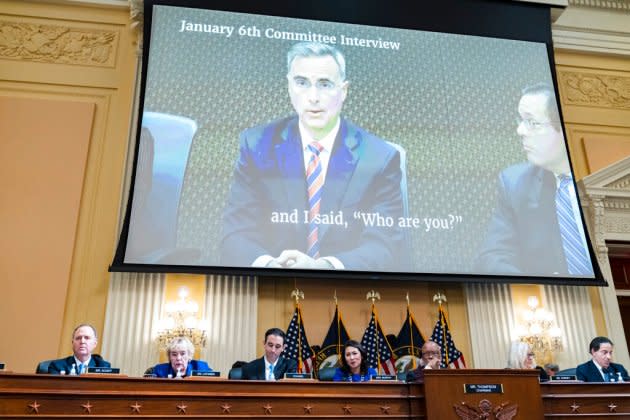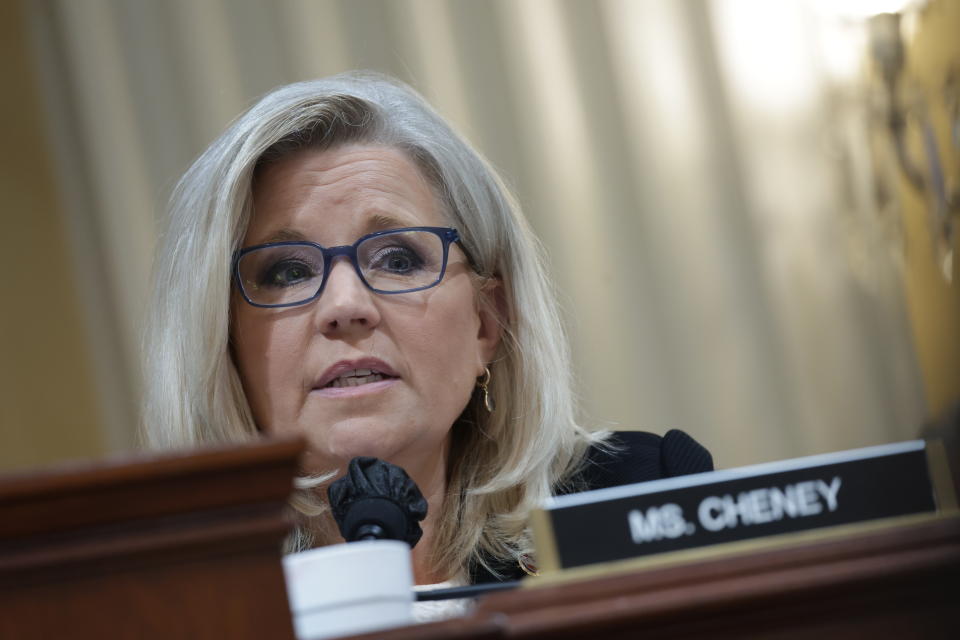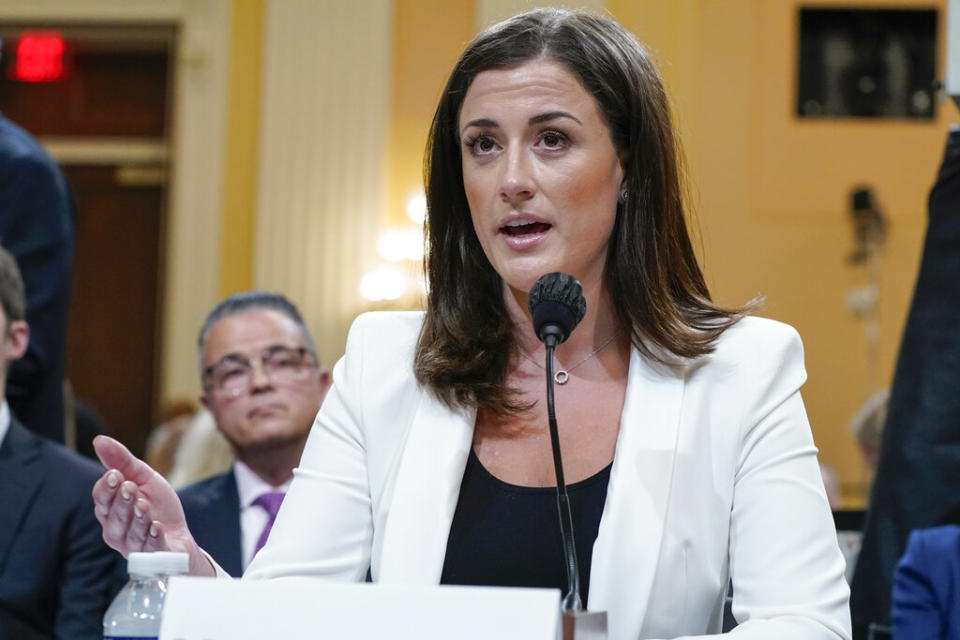The January 6th Committee Streamlined Congressional Hearings Into Riveting Television — But They Are A Rarity That May Not Be Repeated

The January 6th Committee has surprised many in Washington, D.C., by pulling off the unexpected — not just with new revelations but in the way that it has methodically laid out a narrative of Donald Trump’s effort to overturn the election results.
The committee has presented its case as if each hearing was episodic — in brisk, well-produced two-hour chunks that make heavy use of video, audio and graphics.
More from Deadline
'Big Brother' Eviction Pre-Empted By Jan. 6 Committee Hearing, More Broadcast Net Programming Shifts
We’ve seen video of former Attorney General William Barr calling Trump’s claims of election fraud “bullsh*t.” There was the photo of then-Vice President Mike Pence, in a secure location at the Capitol, watching video of Trump praising the mob. We heard a “surprise” witness in Cassidy Hutchinson, the aide to chief of staff Mark Meadows, as she described in detail what she saw and heard on January 6th, most vivid being her story of Trump trying to grab the steering wheel from a Secret Service agent after being told that a trek to the Capitol was a no-go.

GI
The hearings even have used teasers to give viewers a sense of what to expect next. Rep. Liz Cheney (R-WY), the committee’s vice chair, has made a habit of finishing many of the sessions with cliffhangers, the latest being her mention that Trump himself might have tried to tamper with a witness.
Thursday’s hearing, its second in primetime and the last scheduled so far, will focus on the 187 minutes during which Trump failed to act to quell the mob as the Capitol was under attack on January 6, 2021. Witnesses are expected to include Sarah Matthews, former White House deputy press secretary, and Matt Pottinger, former deputy national security adviser.
Rep. Adam Kinzinger (R-IL), a member of the committee, released a tantalizing clip on Thursday morning in which those in Trump’s circle describe how the president was watching TV in the dining room as the siege unfolded.
What was Donald Trump doing while the Capitol was under siege? Take a look. pic.twitter.com/9mz3P6C4qK
— Adam Kinzinger (@RepKinzinger) July 21, 2022
While the hearings have made for riveting television, they’re not necessarily going to be the shape of things to come.
The hearings would have looked far different had not all the members been on the same script — literally, given the committee’s use of Teleprompters. Republicans boycotted the hearings, leaving it to House Speaker Nancy Pelosi (D-CA) to pick all of its members, including Cheney and Kinzinger, both on the outs from the Trump-supporting GOP mainstream.
“I think the conventional wisdom in Washington was, ‘What are they going to have? We already know everything. Is it really going to make a difference? Everybody’s mind is made up,’” said Jonathan Karl, chief Washington correspondent for ABC News. “That was the conventional wisdom. I don’t think you can say that after seeing what they’ve produced.”
Karl said that the hearings have included not just new revelations but also presented information already out there in a number of books, including his own Betrayal, “in a way for the world to see and not from from anonymous sources but from the voices of the people who were there with Donald Trump when all this went down. And maybe the most significant thing is that almost every single witness that has come before this committee is a Republican, and almost all of those Republicans were Trump supporters, people who were appointed by Trump into positions of authority.”
Rep. Adam Schiff (D-CA), a member of the committee, said in a statement that “from the beginning, our committee understood the importance of well-organized public hearings that would lay out what we were learning in a clear, compelling way, through live testimony, deposition videos and a variety of other media so as to be both highly engaging and deeply informative.”
Most congressional hearings are long-winded marathons, as each committee member typically gets a crack at questioning witnesses. Even high-profile sessions, such as the hearings for Trump’s first impeachment and the questioning of Christine Blasey Ford in Brett Kavanaugh’s confirmation hearings, play out as members with dueling realities.

(AP Photo/Jacquelyn Martin, File)
“Under normal circumstances, a congressional hearing is [made up of] long, winding answers about very specific policy, wonky experts who are going to speak at levels that don’t connect with the average American,” said CNN congressional correspondent Ryan Nobles, who has been covering the aftermath of the siege of the Capitol since it happened. “This committee has gone to great lengths to not present what they’ve discovered in a format like that. Their hearings move quick. They make the point that they are going to make then they move on to the next things. They cut through the rigamarole, the ancillary details that don’t get to the core of what they are trying to establish, and they do it in a way that even if you have no experience with January 6th and you are coming into it for the first time, you understand the point they are trying to make.”
The committee tapped James Goldston, the former president of ABC News, to consult, and that has been apparent in the newsmagazine-like feel of the hearings, with packages in which videotaped deposition testimony are delivered in tightly edited snippets.
Eric Herschmann, former senior adviser to Trump, pops up now and then, offering an account of what was unfolding as the president embraced conspiracy theories from the likes of Rudy Giuliani, John Eastman and Sidney Powell. In one offbeat edit at the last hearing, Powell was shown making a remark and then sipping from a can of Diet Dr. Pepper. There were laughs in the hearing room and the clip went viral, in part for its unexpected product placement.
Save for Hutchinson’s hearing, live testimony has been just one feature in the story being told and, given that most of the witnesses have been deposed previously, there is a keen sense among committee members of what to ask and at what point to ask.
There also have been moments where the committee has anticipated Trump and company’s attacks on a witness. When Hutchinson was introduced at the June 28 hearing, the committee showed a 3D graphic of where her office was in the West Wing in relation to Trump’s. As Nobles pointed out, Hutchinson then said in her live testimony that it was even smaller in person. “And so it just drove that point home that even if she wasn’t a policy maker, even if she wasn’t the one making the policy decisions, she at the very least was a fly on the wall, and it was impossible to ignore what she had to say,” Nobles said.
The ratings for the hearings have been solid and steady, albeit not exactly blockbuster. After about 20 million viewers watched the first primetime event on June 9, the daytime hearings have averaged about 11 million viewers across major networks, according to Nielsen. The June 28 testimony of Hutchinson saw a viewership bounce, perhaps helping to draw interest to the next hearing on July 12.
Still, the impact might be better measured in how the hearings have commanded the news cycle, as excerpts spread across social media. Whether coincidental or not, there has been a media focus on polls showing growing numbers of GOP voters preferring a Trump alternative.
Karl points to indicators that Trump’s support “is not as emphatic and broad as it was,” with some polls showing increasing strength for Florida Gov. Ron DeSantis. “These hearings are not going to convince a lot of the hardcore Trump base, but a lot of Republicans who like what Trump did — they didn’t necessarily like everything about his style — those Republicans seeing this, I think it gives them pause, because frankly they weren’t aware of all of this,” Karl said.
The hearings have made their mark in other ways. Scott MacFarlane, congressional correspondent for CBS News, has been covering the legal proceedings of the hundreds of January 6 defendants. He said that “the defendants keep mentioning it in court, saying they are concerned it is resonating with the public and some of the highest-profile defendants in particular are arguing that their trials should be delayed or moved out of Washington, D.C., because of the impact and the publicity of the January 6th Committee hearings.” That was an argument made by attorneys for Steve Bannon, but the judge rejected it, and his trial for contempt of a committee subpoena is underway.
“If you want to hear a well-told story, typically the last place you want to go is a congressional hearing,” MacFarlane said. “This is so different, and I think it gives it potential for having more impact and more resonance with Americans.”
‘Big Brother’ Eviction Pre-Empted By Jan. 6 Committee Hearing, More Broadcast Net Programming Shifts
Broadcast executives had concerns over pre-empting their primetime schedules for the first hearing, but, after seeing the streamlined nature of the proceedings, committed to the next ones. Committee members and staff rehearse each session, something that has helped with timing and has minimized glitches.
Nobles said that the committee is “leaving nothing to chance. When they bring a witness forward, they know exactly how the witness is going to answer every question. And this gets back to, which I don’t think is an unfair criticism, they control the narrative from start to finish.”
Trump has responded most often via Truth Social, and lately he has compared the actions of the Capitol mob to the Late Show with Stephen Colbert show staff, arrested — but not charged — as they were doing a segment on the hearings. The former president groused that “these radical left lunatics, from a failing show, were treated so differently than the unselects are treating so many of our great American patriots. NOT FAIR!”
The hearings may have raised the bar for future high-profile congressional events, especially with the use of video and audio clips, but the January 6th Committee ultimately might have been a rare confluence of events. Even congressional leaders have doubts that this will be the template.
Had House Minority Leader Kevin McCarthy (R-CA) not boycotted the proceedings, the GOP members likely would have demanded equal time in Trump’s defense. The committee investigation likely would have gotten bogged down in questions over subpoenas. And Cheney likely would not be a member.
“She’s driven in a way that I’ve rarely seen a public figure driven over any cause,” Karl said. “This is her life’s mission. … It’s something beyond just, ‘We’re going to do some oversight.’ I don’t think this is much of an exaggeration, maybe not much of an exaggeration at all, that she really believes, and believed from the start, that the survival of the country as we’ve known it depends on the success of these hearings to break through and to make it clear what happened on January 6th.”
Even though this is the culmination of the committee’s planned hearings, there is expectation in the news media that there will be more. The members are still talking to witnesses and gathering new information.
As MacFarlane noted, “if they ruled out doing future hearings, it gives them a little less leverage to go about their ongoing investigation. Maybe it makes it harder to get witnesses to come forward. It makes it harder for witnesses to go in such granular detail as the committee would like. So holding up the possibility of future hearings has given them a little more muscle to seek more depositions and do more investigation.”
Best of Deadline
2022-23 Awards Season Calendar - Dates For The Oscars, Emmys, Grammys, Guilds, Festivals & More
NFL 2022 Schedule: Primetime TV Games, Thanksgiving Menu, Christmas Tripleheader & More
Sign up for Deadline's Newsletter. For the latest news, follow us on Facebook, Twitter, and Instagram.


